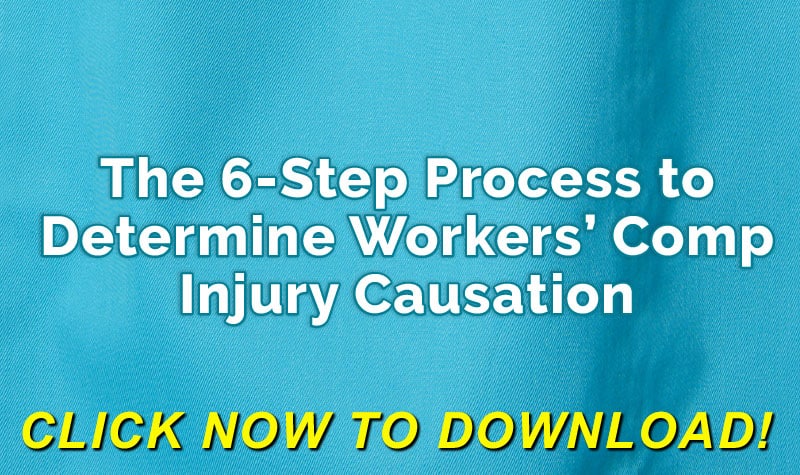
Safety is just one concern, however. The other is cost; they generally are priced significantly higher than similar, FDA-approved drugs or the sum of their underlying medications.
Both the utilization and the average cost of compounded medications in the workers’ compensation system has decreased in recent years. However, there are still pockets of excessive use. Stakeholders need to maintain a steady and continued focus on efforts to curb the unnecessary use of these pharmaceuticals.
Problems Cited
Compounds are a mixture of drugs intended for a specific patient’s use. According to an FDA report, they are beneficial only in limited circumstances; such as when other medications have failed, a patient is allergic to some of the inactive ingredients or has difficulty swallowing.
Click Link to Access Free PDF Download
“The 6-Step Process To Determine Workers’ Comp Injury Causation”
The federal agency inspected compounding facilities and noted the following “troubling conditions” that could lead to widespread harm of patients:
- Toaster ovens used for sterilization.
- Pet beds near sterile compounding areas.
Latest Stats
Compounded medications are not considered first-line therapy for pain or other common conditions of injured workers according to industry guidelines, such as evidence-based medicine guidelines from Work Loss Data Institute, American College of Occupational and Environmental Medicine, and many other state-specific guidelines.
Compounds are available in many applications but are used in workers’ compensation most often as topical products for pain management. Usually, compounded medications are excluded from workers’ compensation formularies, and require prior authorization before they are dispensed to an injured worker.
State legislatures and organizations within the workers’ compensation system have taken steps in recent years to reduce the overuse of compounds, and they have been largely effective, according to the most recent Drug Trend Report in the workers’ compensation system from myMatrixx:
- Spending on compounded medications declined 37.1 percent in 2017
- It was the third year in a row that payer spending on compounded drugs has decreased
- Compounds fell from the top 10 therapy classes
- Utilization decreased 21.2 percent
- The average cost of compounded medications decreased 15.9 percent
Along with the good news, however, are some disturbing reports.
Recent Problems
- Pennsylvania. A recent report found that legislative reforms in the state resulted in cost savings on physician-dispensed drugs; however, they were offset by an increase in pharmacy dispensing of expensive compound drugs.
The legislation that took effect in December 2014 capped prices paid for physician-dispensed drugs and restricted physician’s ability to dispense opioids and other drugs to limited timeframes. The Workers Compensation Research Institute found there was an associated decrease in the number of injured workers who received physician-dispensed drugs. But they also found there was a “dramatic” increase in the prescription payments for compound drugs in the same years, which it attributed to the emergence of new pharmacies dispensing expensive drug products, especially compound drug prescriptions.
- Texas. A loophole in the state’s drug formulary allowed compound prescriptions to be filled without obtaining preauthorization to confirm medical necessity. Regulators said the workers’ compensation system saw a 46.4 percent increase in compound prescriptions from 2010 to 2014, with the total cost of an average prescription more than doubling from $356 to $829.
Solutions
A new rule amended the Texas formulary to exclude any prescription drug created through compounding and required preauthorization for all compounded medications. That rule took effect July 1. Several additional states have adopted similar measures, including Arkansas, Oklahoma, Florida, Nevada and Tennessee, and the idea is being considered in other jurisdictions.
The National Conference of Insurance Legislators is considering model legislation with clearly established guidelines for the reimbursement of pharmaceutical products in the workers’ compensation system. It includes language that would limit compound medications and require a critical evaluation with a physician documented statement of medical necessity or a utilization review of the compounded pharmaceutical products.
Stakeholders can work closely with state regulators and legislators. Additional ways to address the issue of excessive use of compound medications include:
- Working closely with a pharmacy benefit manager to ensure compounds are used judiciously and only when preauthorized
- Payment limits. Placing reimbursement limits per each script or per each ingredient in a compound medication
- Limiting the number of ingredients or the total cost per script
- Retrospective review. Allowing employers the option to deny coverage for a compound medication that has not been preauthorized
- Network pharmacies. Allowing employers to direct injured workers to specific pharmacies
- Including compound medications in the list of medications allowed only with preauthorization
Conclusion
The overuse of compound medications has been a troubling area for workers’ compensation stakeholders for several years. Strategies to address the issue are effective but must be continually employed and updated to ensure the problem is appropriately managed.

Author Michael Stack, CEO Amaxx LLC. He is an expert in workers’ compensation cost containment systems and helps employers reduce their workers’ comp costs by 20% to 50%. He works as a consultant to large and mid-market clients, is a co-author of Your Ultimate Guide To Mastering Workers Comp Costs, a comprehensive step-by-step manual of cost containment strategies based on hands-on field experience, and is founder & lead trainer of Amaxx Workers’ Comp Training Center.
Contact: mstack@reduceyourworkerscomp.com.
Workers’ Comp Roundup Blog: https://blog.reduceyourworkerscomp.com/
©2018 Amaxx LLC. All rights reserved under International Copyright Law.
Do not use this information without independent verification. All state laws vary. You should consult with your insurance broker, attorney, or qualified professional.






